Virtually every green event checklist includes a call to curb food waste. Here on Event Manager Blog we’ve shared a few ideas to consider. But how does a meeting planner practically implement a food waste reduction program? After all it’s not all about checklists. What process steps do you follow?
I recently shadowed event planner Sandra Wood, CMP, on her mission to curb food waste at the Canadian Medical Association’s (CMA) Annual Meeting in Ottawa, where her team prevented three metric tons of food waste. Her plan models seven steps you can duplicate at your event to save money, help those in need and protect the planet.
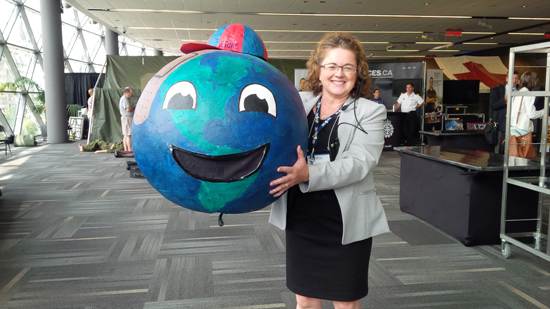
Step 1: Make it a priority and proactively plan for it
The case for curbing food waste is really a no brainer: trashing food is a $200 billion problem in the US ($165 billion) and Canada ($27 billion), and has significant environmental impacts. Solutions start by making it a priority to understand how events contribute and can take systematic action. Ideally, you can include waste-wise expectations in agreements. In Sandra’s case, lack of contracted agreements did not deter CMA from communicating food waste reduction priorities to caterers regularly. Sandra actively campaigned three caterers to get them involved by hosting a formal pre-planning meeting to set an action plan, which was documented and shared with all team members six months prior to the Annual Meeting.
Step 2: Think upstream reduction and downstream diversion
Food waste fighting starts long before managing leftovers, so be open to creative ideas that reduce waste up-front. Remember heavy customization can impede your caterer’s ability to estimate order quantities, which are typically more precise if you order off the menu. Pay careful attention to histories, guarantees, food packaging and service styles when planning menus. Try to eliminate disposables by providing reusable dishware at all functions. In addition to these steps, CMA also hosted a Meatless Monday lunch for attendees, which reduced water and carbon impact and presented cost savings.
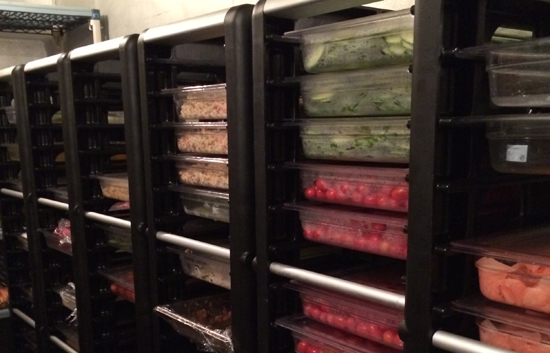
The Westin Ottawa catering team uses durable food containers to reduce the amount of plastic wrap in their kitchen
Step 3: Know your risk and liabilities: Health and safety first!
Most food waste reduction strategies will consider food donation programs. So research and address any risks or liabilities when it comes to redistributing food. Look to Good Samaritan legislation to assist, especially in the case of prepared food items. As a health-related organization, CMA is very serious about providing safe, healthy food. Legal consult was sought, and a food distribution agency was used to ensure proper guidelines were followed.
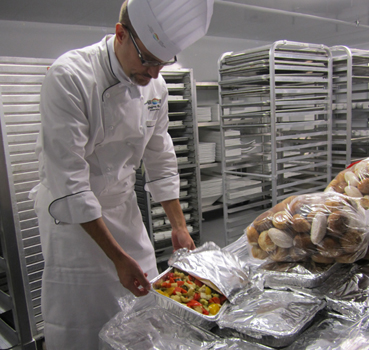 ”
”
The Shaw Centre (formerly Ottawa Convention Centre) packages safe food for donation from CMA’s Annual Meeting
Step 4: Find and share resources that help
Thankfully, there are more and more resources to fight food waste emerging daily. These include business sites such as Unilever’s Food Waste program, and redistribution agencies like Rock and Wrap it Up. As a Canadian association, CMA used Quebec-based La Tablée des Chefs to support their donation program. This was the second year of work with this group, who also helped with CMA’s 2013 Annual Meeting in Calgary. 540 meals were able to be provided through food donation from CMA’s 2014 Annual Meeting.
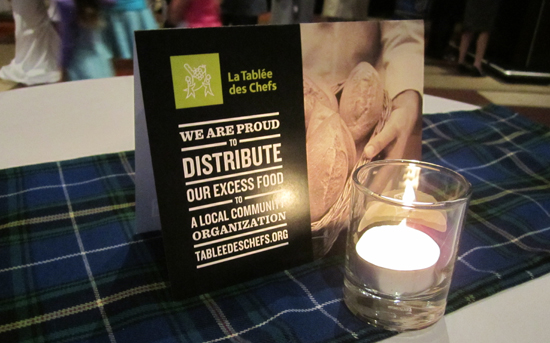 ”
”
CMA reception attendees were informed of food donation programs, which received positive reviews from beneficiaries like the Shepherds of Good Hope
Step 5: Anticipate and train for new service norms
Fighting food waste is all good in theory. But are you going to panic if your buffets empty before they are refreshed? This is uncomfortable territory for most event professionals, so it is critically important that everyone discuss service expectations upfront in a very specific way. If buffets trays are regularly swapped out at 5%, is everyone comfortable to drop to 1%? Is the kitchen or hot box close enough to enable prompt refresh when it is really needed? What kind of re-training do servers need to resist the urge to pre-pour, pre-set and over-serve? All of these scenarios were discussed in an up-front and honest way as part of CMA’s pre-planning meetings. This helped to generate creative ideas like reserving tables at the back of the room that were not pre-set until other seats at plated functions were full, helping the kitchen to hold overage for donation, rather than release it to the floor, demoting it to compost.
Step 6: Lead by example and don’t be afraid to get your hands dirty
Sometimes preventing food waste means you have to pull on some gloves and rescue those sandwiches that accidentally got tossed in the landfill, and divert them to a composting program. All food that was unfit for donation from CMA’s Annual Meeting was composted. During the event, CMA staff went back of house regularly to record types and volume of food that was being discarded, making sure it was placed in the proper bin.
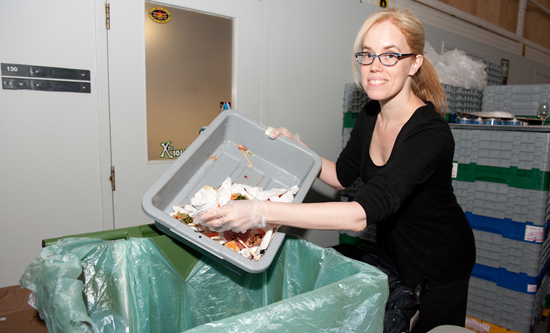 ”
”
Yours truly gets hands-on helping food services staff recover 251 Kg of post-consumer food waste at the Canadian Air and Space Museum
Step 7: Measure, report and continuously improve
Reducing food waste is a nice, warm-fuzzy thing to do. But what impact do your efforts have? Request caterers to measure things like cost impacts, organic waste and food donation. In the case of CMA, the Westin Ottawa and Shaw Centre were fully engaged in measuring food waste, thanks to Sandra’s up-front efforts. 2,915 Kg of food waste were diverted through composting and donation programs at CMA’s Annual Meeting, helping achieve an 80% waste diversion from landfill rate.
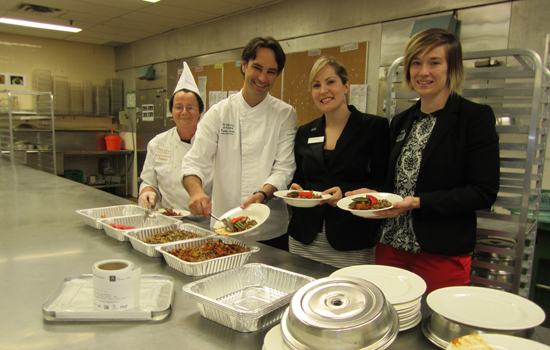 ”
”
The Westin Ottawa packages up Meatless Monday entrees for redistribution to local charities during CMA’s Annual Meeting
In Conclusion
As with many green event practices, the theory of tackling food waste can often not match the reality. The good news is, even a beginner can start a conversation with caterers to understand how to curb and measure food waste. So what’s your next step to win the food waste war?





